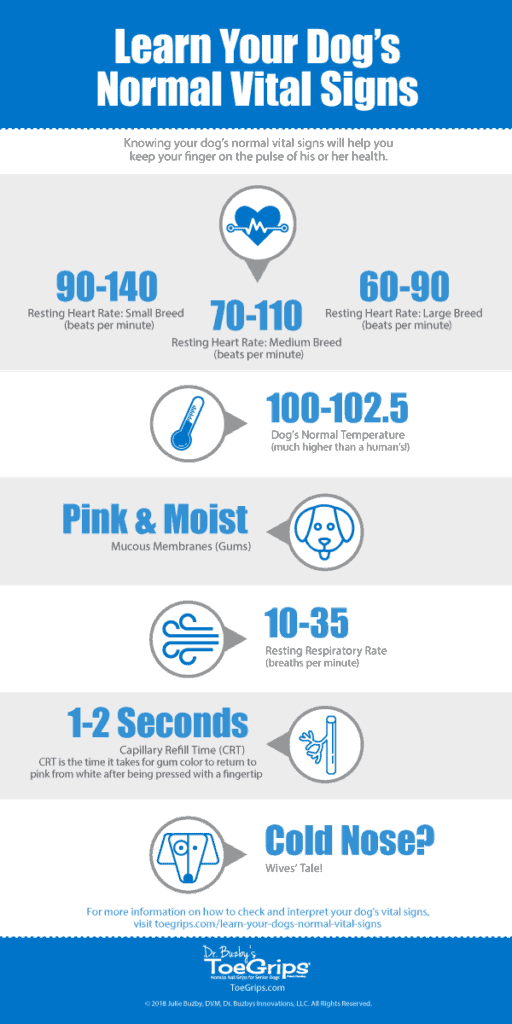A normal breathing rate for a dog is around 10 to 30 breaths per minute. Your dog’s breathing rate is an important indicator of their overall health.
We will explore what is considered a normal breathing rate for dogs and what factors can affect it. Understanding your dog’s breathing patterns can help you identify any potential respiratory issues or distress. It is crucial to monitor your dog’s breathing rate regularly and be aware of any variations from their normal range.
We will also discuss when it is necessary to seek veterinary attention if your dog’s breathing rate exceeds or falls below the normal range. By being proactive and observant, you can ensure your dog’s respiratory well-being and provide timely care if needed.

Credit: toegrips.com
Understanding Dog Breathing
Dogs have a unique respiratory system that plays a crucial role in their overall health and well-being. Understanding how dogs breathe and what is considered normal in terms of their breathing rate is essential for responsible dog owners. Monitoring their breathing can help detect any potential health issues early on, ensuring timely intervention and necessary treatment.
An Overview Of Dog Respiratory System
The dog’s respiratory system consists of various organs and structures that work together to facilitate breathing. This system includes the nose, mouth, windpipe (trachea), lungs, and diaphragm. When a dog inhales, air is drawn in through their nose or mouth, passes through the windpipe, and into the lungs. The lungs then extract oxygen from the air and expel carbon dioxide during exhalation. The diaphragm, a domed-shaped muscle located beneath the lungs, plays a vital role in this process by contracting and relaxing, helping to regulate the dog’s breathing.
The Importance Of Monitoring Breathing Rate
- Monitoring your dog’s breathing rate is crucial for several reasons.
- Changes in breathing patterns can indicate underlying health issues.
- High respiratory rates may indicate stress, pain, or anxiety.
- Abnormal breathing rates can be a sign of respiratory problems.
- Observing your dog’s breathing rate can help identify emergencies.
It is important to note that the normal breathing rate for dogs can vary depending on factors such as size, breed, age, and activity level. On average, a healthy dog’s breathing rate ranges between 15 to 30 breaths per minute. Puppies and smaller breeds tend to have higher respiratory rates compared to larger dogs.
| Breathing Rate (Breaths per Minute) | Category |
|---|---|
| 15 to 30 | Normal Breathing Rate |
| 30 to 40 | Mildly Elevated Breathing Rate |
| More than 40 | High Breathing Rate |
Note: It is important to consult with a veterinarian if you notice any significant changes in your dog’s breathing rate, such as persistent high respiratory rates or difficulty breathing.

Credit: vcahospitals.com
Normal Breathing Rate For Dogs
Dogs have unique respiratory systems that help regulate their body temperature and ensure oxygen flow throughout their bodies. Understanding a dog’s normal breathing rate is essential for assessing their overall health and well-being.
Factors Affecting Breathing Rate
Several factors can influence a dog’s breathing rate, including:
- Exercise level
- Temperature
- Anxiety or stress
- Pain or discomfort
- Obesity or overweight
These factors can cause temporary fluctuations in breathing rate, but it’s crucial to be aware of what is considered normal for your furry friend.
Average Breathing Rates For Different Sizes And Breeds
The average breathing rate for dogs can vary based on their size and breed. Here’s a general guideline:
| Breed Size | Average Breathing Rate (breaths per minute) |
|---|---|
| Small | 15 – 20 |
| Medium | 12 – 20 |
| Large | 10 – 30 |
Please note that these ranges are approximate and may vary depending on individual factors.
Normal Breathing Rates For Puppies, Adult Dogs, And Senior Dogs
The breathing rates for dogs can also differ based on their age. Here are some typical breathing rates for different life stages:
- Puppies: 15 – 40 breaths per minute
- Adult Dogs: 10 – 30 breaths per minute
- Senior Dogs: 10 – 30 breaths per minute
It’s important to note that these ranges are general guidelines. If your dog’s breathing rate exceeds or falls significantly below these averages, it may indicate an underlying health issue, and you should consult with a veterinarian.
Signs Of Abnormal Breathing
When it comes to our furry friends, understanding their breathing patterns is crucial for their overall well-being. Dogs normally have a steady and rhythmic breathing rate, but sometimes their breathing can indicate an underlying health issue. In this article, we will explore the signs of abnormal breathing in dogs and when it’s time to consult a veterinarian.
Fast Or Rapid Breathing
Dogs might experience episodes of fast or rapid breathing, which can be a cause for concern. Rapid breathing, also known as tachypnea, is defined as an increased number of breaths per minute. If you observe your dog breathing more rapidly than usual, it could be a sign of an underlying problem.
Some possible causes of fast or rapid breathing in dogs include:
- Anxiety or stress
- Heatstroke
- Heart or lung disease
- Pain
If your dog is breathing rapidly and you notice other concerning symptoms such as coughing, wheezing, or lethargy, it is important to consult your veterinarian for a proper diagnosis and treatment.
Slow Or Labored Breathing
In contrast to rapid breathing, slow or labored breathing can also be a sign of an issue. Dogs with labored breathing may appear to be working harder to breathe, and their breaths may be shallow or accompanied by wheezing or rasping sounds.
Possible causes of slow or labored breathing in dogs may include:
- Respiratory infections
- Allergies
- Obstructions in the airway
- Heart disease
If you notice your dog struggling to breathe or experiencing slow, labored breaths, it is crucial to seek veterinary attention immediately. Prompt intervention can help prevent further complications and ensure your dog receives the appropriate treatment.
Irregular Breathing Patterns
In some cases, you might notice that your dog’s breathing is irregular or erratic. Irregular breathing patterns can manifest as quick breaths followed by long pauses or shallow, irregular breaths.
Irregular breathing patterns may be caused by various factors, including:
- Allergies or respiratory infections
- Anxiety or stress
- Neurological issues
- Heart problems
Pay close attention to your dog’s breathing patterns, and if you observe irregularities or abnormal patterns, consult your veterinarian for further evaluation. Early detection and treatment can significantly improve your dog’s health and well-being.
When To Consult A Veterinarian
Knowing when to consult a veterinarian is crucial for the overall health and well-being of your furry companion. If you notice any of the following signs along with abnormal breathing, it is recommended to seek professional guidance:
- Excessive panting
- Cyanosis (blue tint to the gums or tongue)
- Lethargy
- Coughing or wheezing
- Loss of appetite
- Collapsing
Remember, early intervention is key in diagnosing and treating any underlying conditions affecting your dog’s breathing. Always prioritize your dog’s health and consult a veterinarian if you have any concerns about their breathing patterns.

Credit: www.thewildest.com
Frequently Asked Questions On How Many Breaths Per Minute Is Normal For A Dog
How Many Breaths Per Minute Is Concerning For A Dog?
A breathing rate above 30 breaths per minute in dogs can be concerning.
What If My Dog’s Resting Respiratory Rate Is 40?
If your dog’s resting respiratory rate is 40, it may be within the normal range. However, it’s always important to monitor your dog’s breathing patterns and consult with a veterinarian if you have concerns about their health.
Is It Normal For A Dog To Breathe 60 Times A Minute While Sleeping?
Yes, it is normal for a dog to breathe around 60 times per minute while sleeping.
What Is Respiratory Distress In Dogs?
Respiratory distress in dogs refers to difficulty breathing, often caused by various factors like allergies, infections, or heart and lung diseases. It can be observed through symptoms like rapid or shallow breathing, wheezing, coughing, and blue gums. Immediate veterinary attention is crucial for diagnosing and treating the underlying cause of respiratory distress in dogs.
Conclusion
To sum up, understanding the normal respiratory rate for dogs is crucial for their overall health and well-being. Monitoring their breathing can give important insights into their current state and help detect any potential health issues. By knowing what is considered normal and what is not, you can provide the necessary care and seek veterinary assistance if needed.
So, pay close attention to your furry friend’s breathing and ensure they stay healthy and happy.



